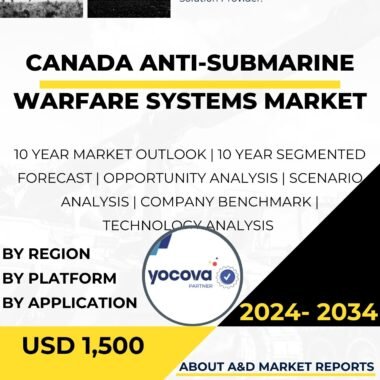Description
Malaysia Anti-Submarine Warfare Systems Market
The Malaysia anti-submarine warfare systems market has experienced significant growth and interest as the nation recognizes the importance of enhancing its naval defense capabilities. ASW systems play a crucial role in safeguarding maritime interests and countering potential submarine threats in the region’s strategic waters.
One of the primary drivers behind the growth of the ASW systems market in Malaysia is the country’s strategic geographical location. Situated in the heart of Southeast Asia, Malaysia’s maritime domain is vital for international trade and economic activities. As a result, securing its territorial waters and exclusive economic zone (EEZ) is essential to protect its maritime interests and ensure regional stability.
The growing presence of submarines operated by both regional and global naval powers has heightened the need for advanced ASW capabilities. Submarines possess stealth and long-range strike capabilities, making them formidable naval assets that can threaten Malaysia’s maritime security. Therefore, investing in cutting-edge ASW systems is critical to maintain a credible deterrent against potential adversaries.
Moreover, the threat of maritime terrorism and illicit activities, such as drug trafficking and piracy, in the surrounding waters underscores the importance of robust maritime defense capabilities. ASW systems provide the Malaysian Navy with the ability to detect, track, and neutralize potential hostile submarines and mitigate asymmetric threats in the maritime domain.
Furthermore, the expansion of the ASW systems market is driven by Malaysia’s commitment to developing indigenous defense capabilities. Collaborations between the government and local defense companies, as well as partnerships with international ASW system manufacturers, can facilitate technology transfer and expertise development, fostering the growth of Malaysia’s defense industry.
Additionally, the ASW systems market offers economic benefits through job creation and attracting foreign direct investment. As the demand for advanced ASW systems increases, local manufacturing and maintenance facilities can be established, generating employment and enhancing Malaysia’s defense industrial base.
The Malaysia ASW systems market encompasses a diverse range of technologies and capabilities, including sonar systems, anti-submarine torpedoes, underwater sensors, and ASW helicopters. Sonar systems are at the heart of ASW capabilities, enabling the detection and tracking of submarines through active and passive sonar techniques.
Anti-submarine torpedoes are critical munitions used to engage and neutralize hostile submarines. These weapons are designed for precision strike capabilities, allowing naval forces to respond swiftly and decisively to submarine threats.
Moreover, underwater sensors play a vital role in monitoring and surveilling underwater environments for submarine activity. These sensors enhance situational awareness and contribute to a comprehensive ASW defense strategy.
Additionally, ASW helicopters equipped with advanced sonobuoys and dipping sonar systems are valuable assets for maritime patrol and ASW missions. These helicopters extend the range and effectiveness of ASW operations, offering increased coverage and surveillance capabilities.
However, several challenges must be addressed to fully realize the potential of the ASW systems market in Malaysia. One significant obstacle is the cost associated with acquiring and maintaining advanced ASW technologies. Ensuring cost-effectiveness and efficient resource allocation will be crucial to sustain the development and deployment of these systems.
Moreover, ensuring the integration and interoperability of ASW systems with other naval assets, such as surface ships, maritime patrol aircraft, and maritime surveillance radars, is essential for coordinated and effective maritime defense operations.
Additionally, investing in the training and development of skilled personnel is critical for effectively operating ASW systems. Adequate training programs and knowledge transfer initiatives will ensure that naval personnel are proficient in handling these sophisticated technologies.
Furthermore, ensuring the reliability and effectiveness of ASW systems in various operational environments and against different submarine threats requires rigorous testing and evaluation. Conducting realistic exercises and simulations will verify the systems’ performance and validate their capabilities in real-world scenarios.
In conclusion, the Malaysia ASW systems market has experienced significant growth as the nation recognizes the importance of enhancing its naval defense capabilities. The acquisition and deployment of advanced ASW technologies are essential to protect Malaysia’s territorial waters, counter potential submarine threats, and maintain regional stability. Efforts to develop indigenous defense capabilities through research and development initiatives and partnerships with international ASW system manufacturers are crucial for sustainable growth in the market. Addressing challenges related to cost, interoperability, personnel training, and system reliability will be essential to ensure the successful integration and operation of ASW systems in Malaysia’s naval defense strategy. By investing in cutting-edge ASW technologies and fostering collaborations between the government and defense industry players, Malaysia can enhance its naval capabilities, secure its maritime interests, and contribute to regional security and stability.




